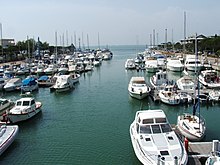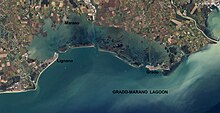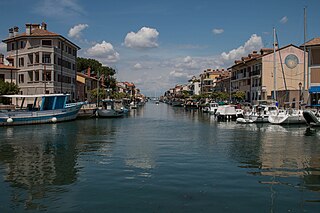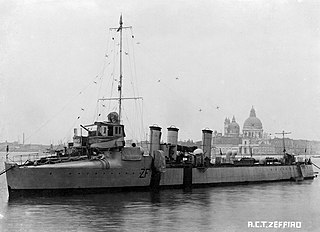| Designations | |
|---|---|
| Official name | Laguna di Marano: Foci dello Stella |
| Designated | 14 May 1979 |
| Reference no. | 190 [1] |

Marano Lagoon is a huge lagoon in northeastern Italy. It has a surface area of around 160 square kilometres (62 sq mi).
| Designations | |
|---|---|
| Official name | Laguna di Marano: Foci dello Stella |
| Designated | 14 May 1979 |
| Reference no. | 190 [1] |

Marano Lagoon is a huge lagoon in northeastern Italy. It has a surface area of around 160 square kilometres (62 sq mi).
Marano Lagoon stretches from Lignano Sabbiadoro to the east for about 30 kilometres (19 mi). It is considered the twin of the Venice Lagoon, that is located a few kilometers to the west. [2] Sometimes it is called Marano-Grado Lagoon, but geographically it is divided in two sections: Marano Lagoon and Grado Lagoon.

The section usually called "Grado Lagoon" is an Italian lagoon located in the northern Adriatic Sea which extends from the island of Fossalon (near Grado) to the island of Anfora, next to the mouth of the small river Aussa. [3]
The lagoon, which covers an area of about 90 square kilometres (35 sq mi) and has nearly 120 islands, is divided into an eastern sector (called in Italian "Palud de sopra") and a western sector ("Palud de soto"). [4]
The origins of the lagoon are relatively recent. Until the fifth century the land covered all the area, as evidenced by several archaeological findings, including a Roman road, now entirely covered by water, which connected Aquileia to its port of Grado.
Characteristic of the Grado lagoon is the presence of houses called casoni, simple homes with roofs of straw used by the fishermen of Grado.
The typical boat of the inhabitants of the lagoon is the batèla, which has a flat bottom and is operated by rowing. A batèla is usually 5 to 10 metres (16 to 33 ft) long, is guided by an oarsman standing in the stern, and may be equipped with a sail.
The lagoon, which is bordered to the west by the section called Marano Lagoon, is crossed longitudinally by the Venetian Coastal Waterway, which connects Venice with the mouth of the Isonzo river.

The West Lagoon (Palud de soto) is the larger lagoon and includes nearly 100 islands, like the beautiful island of Martignano. It is crossed by numerous canals, which are arranged along the main islands. Among the islands, near Grado, is the small island of San Pietro d'Orio, which for centuries was the seat of a monastery; the island of Ravaiarina, which is now is the site of fishing ponds and facilities, and the island of Gorgo, formerly called Saints Cosimo and Damiano, which previously housed a church and, during World War II, an Italian military base.
Farther west of Grado in the direction of Marano Lagoon are, among other small islands, the island of Morgo, which has widespread vegetation and was well known in the past for its agricultural production, and the island of Beli, which owes its name to the legendary witch Bela who confused sailors. The westernmost island is Anfora, which acquired strategic importance in 1866 when it became the boundary between Italy and the Austrian Empire, which became Austria-Hungary in 1867. Today it houses the small island town of Porto Buso.

The East Lagoon (Palud de sora) is more recent and shallower. After a land reclamation project at the island of Fossalon which took place in the first half of the 20th century, the East Lagoon's water area is substantially halved. The Valle Cavanata Nature Reserve lies in the reclaimed land. [5]
Compared to the Western Lagoon, the East Lagoon has fewer islands, but they have a large number of huge trees, notably on the easternmost island of Panera. Between the islands stands Barbana, which is home to the 1,500-year-old Sanctuary of Mary, Mother of Jesus and is permanently inhabited by a community of Franciscan friars. The island is visited each year during the celebration of the Perdòn di Barban, a pilgrimage which on the first Sunday in July which includes a procession in the lagoon from Grado to Barbana of boats decorated with flags . [6]
The island of Schiusa, recently created with fill material and now entirely urbanized and integrated with Grado, lies in the East Lagoon.
The island-town of Grado, which, like Venic, historically consisted of small islands, is the largest of the Grado Lagoon and is located just 20 kilometres (12 mi) from the mouth of the river Isonzo.

The Marano Lagoon section covers an area of 70 square kilometres (27 sq mi) and has fewer islands than the Grado Lagoon section. Sometimes the Grado and the Marano lagoons are considered a single huge lagoon called in Italian "Grado-Marano Laguna" or "Laguna di Grado, stretching from Grado to Lignano Sabbiadoro and called "the twin sister of the Venice Lagoon (Laguna di Venezia). However the Marano Lagoon is under the administration of the " Comune di Marano Lagunare" while the eastern Grado Lagoon section is administered mainly by the Comune di Grado.
The Marano section of the lagoon is crossed longitudinally by the "Venetian coast waterway", a waterway that connects Venice with the mouth of the Isonzo. This section starts on the southern side with Lignano Sabbiadoro, a resort city developed mainly after World War II. The Marano section stretches to the Palud de Soto near Porto Buso and the island of Anfora, next to the mouth of the small river Aussa.
The mooring complex (marina) of Lignano Sabbiadoro is the largest in Italy and among the largest in Europe, having more than 5,000 berths. The various structures of Aprilia Marittima, the harbour Marina Punta Faro, and the docks Porto Vecchio are strategically positioned around and near the southern areas of the Marano Lagoon.
The Nature Reserve of the Marano Lagoon stretches over more than 1,400 hectares (3,459 acres), and it actually consists of two smaller reserves, the Reserve of the Stella River Mouth (Riserva Foci dello Stella) and the Reserve of the Nuovo Valley Canal (Riserva Valle Canal Novo). The environment consists mainly of reed thickets, water, and sandbanks. What is specific to the Marano Lagoon is the variety of water salinity levels. This variety has enabled the development of an impressive biodiversity, both on land and in water. However, bird life is the most prominent in the lagoon, which is why birders are highly likely to get a special satisfaction while visiting the lagoon. [7]

The most important of the nearly 120 islands in the Marano-Grado Lagoon are:

The Venetian Lagoon is an enclosed bay of the Adriatic Sea, in northern Italy, in which the city of Venice is situated. Its name in the Italian and Venetian languages, Laguna Veneta—cognate of Latin lacus, "lake"—has provided the English name for an enclosed, shallow embayment of salt water, a lagoon.

Friuli-Venezia Giulia is one of the 20 regions of Italy and one of five autonomous regions with special statute. The regional capital is Trieste on the Gulf of Trieste, a bay of the Adriatic Sea.

Mazzorbo is one of various islands in the northern part of the Lagoon of Venice. Like the other islands in this part of the lagoon, it was the site one of the earliest settlements in the lagoon which predated the development of Venice. However, these islands then declined and were eventually abandoned. In the 1980s the architect Giancarlo De Carlo built a brightly coloured residential neighbourhood to help to repopulate Mazzorbo. In 2019 its population was 256. It is linked to Burano by a wooden bridge. It was once an important trading centre but is now known for its vineyards and orchards. Its main attraction is the fourteenth century church of Santa Caterina.
The Bassa Friulana is a low-lying and level area of Friuli, specifically the very southern part of the provincies of Pordenone, Udine and Gorizia in the north-eastern Italian region of Friuli-Venezia Giulia.

Sottomarina is a small town on a peninsula which has the same name. It is a frazione of the comune of Chioggia, which is part of the Metropolitan City of Venice in the Veneto region in north-eastern Italy.

Grado is a town and comune (municipality) of 8,064 residents in the Regional decentralization entity of Gorizia in the north-eastern Italian region of Friuli-Venezia Giulia, located on an island and adjacent peninsula of the Adriatic Sea between Venice and Trieste. The territory of the municipality of Grado extends between the mouth of the Isonzo and the Adriatic Sea and the Grado Lagoon, and covers an area of about 90 square kilometers between Porto Buso and Fossalon. Characteristic of the lagoon is the presence of the casoni, which are simple houses with thatched roof used in the past by the fishermen of Grado, who remained in the lagoon for a long time, returning to the island of Grado only during the colder period of the year.

Portus was a large artificial harbour of Ancient Rome. Sited on the north bank of the north mouth of the Tiber, on the Tyrrhenian coast, it was established by Claudius and enlarged by Trajan to supplement the nearby port of Ostia.

The Tagliamento is a braided river in north-east Italy, flowing from the Alps to the Adriatic Sea at a point between Trieste and Venice.

Lignano Sabbiadoro is a town and comune (municipality) in the Regional decentralization entity of Udine, in the Friuli-Venezia Giulia region of north-eastern Italy. It is one of the main summer resorts in northern Italy and on the Adriatic Sea coast.

Actv S.p.A. is a public company responsible for public transportation in Venice and Chioggia municipalities and for interurban bus services in province of Venice. ACTV is not responsible for Venice People Mover or waterbus routes between airport and the lagoon area. Connections by bus with Venice airport are managed by ACTV and by ATVO.

The Lagunari Regiment "Serenissima" is the active unit of Italian Army's infantry arm's amphibious Lagunari speciality. The name of the specialty comes from the Italian word for lagoon, while the regiment's name "Serenissima" commemorates the Most Serene Republic of Venice. The regiment is based in Venice and assigned to the Cavalry Brigade "Pozzuolo del Friuli". The "Pozzuolo del Friuli" brigade forms, together with the Italian Navy's Third Naval Division and San Marco Marine Brigade, the Italian Armed Forces' Sea Projection Force.

Barbana is a small island located at the northern end of the Grado Lagoon, near Trieste in north-east Italy. It is the site of the Santuario di Barbana, an ancient Marian shrine, whose origins date back to 582 when Elia, the Patriarch of Aquileia, built a church near the hut of a hermit from Treviso named Barbanus. The island, which can be easily reached by ferry from nearby Grado, is populated by a small community of Franciscan friars.
Macrostomum lignano is a free-living, hermaphroditic flatworm. It is transparent and of small size, and is part of the intertidal sand meiofauna of the Adriatic Sea. Originally a model organism for research on developmental biology and the evolution of the bilaterian body plan, it has since expanded to other important fields of research such as sexual selection and sexual conflicts, ageing and the evolution of the bilaterian body plan, ecotoxicology, and, more recently, genomics.
Isola di San Clemente is a small island in the Venetian Lagoon in Italy. For centuries it housed a monastic settlement, and more recently an asylum. It is now the site of a luxury hotel.
Gronda lagunare is a term used to indicate the area of the Lagoon of Venice by its mainland shore. The term is derived from the fact that it receives the waters from the rivers and streams which flow into the lagoon from the drainage basin of the plain of the mainland by the lagoon. It is also reached by the tidal flows form he sea., it is meant to be a belt that forms a transition area between the open lagoon and the mainland.

The raid on Porto Buso was an assault launched by the Italian Royal Navy on an Austro-Hungarian naval station and border post located in Porto Buso island, in the Marano-Grado Lagoon, in the first hours of 24 May 1915, the day when the Kingdom of Italy entered World War I on the side of the Entente. The incursion became the first offensive action of the Italian Navy in the conflict, and ended with the destruction of the naval outpost, the sinking of a flotilla of small vessels and the capture of the majority of the Austro-Hungarian garrison. The action eventually resulted in the withdrawal of all Austro-Hungarian forces from the nearby town of Grado and neighbouring islands during the subsequent days.

Zeffiro ("Zephyr") was an Italian Nembo-class destroyer. Commissioned into service in the Italian Regia Marina in 1905, she served in the Italo-Turkish War and World War I, playing an active role in the Adriatic campaign. Reclassified as a torpedo boat in 1921, she was decommissioned in 1924.